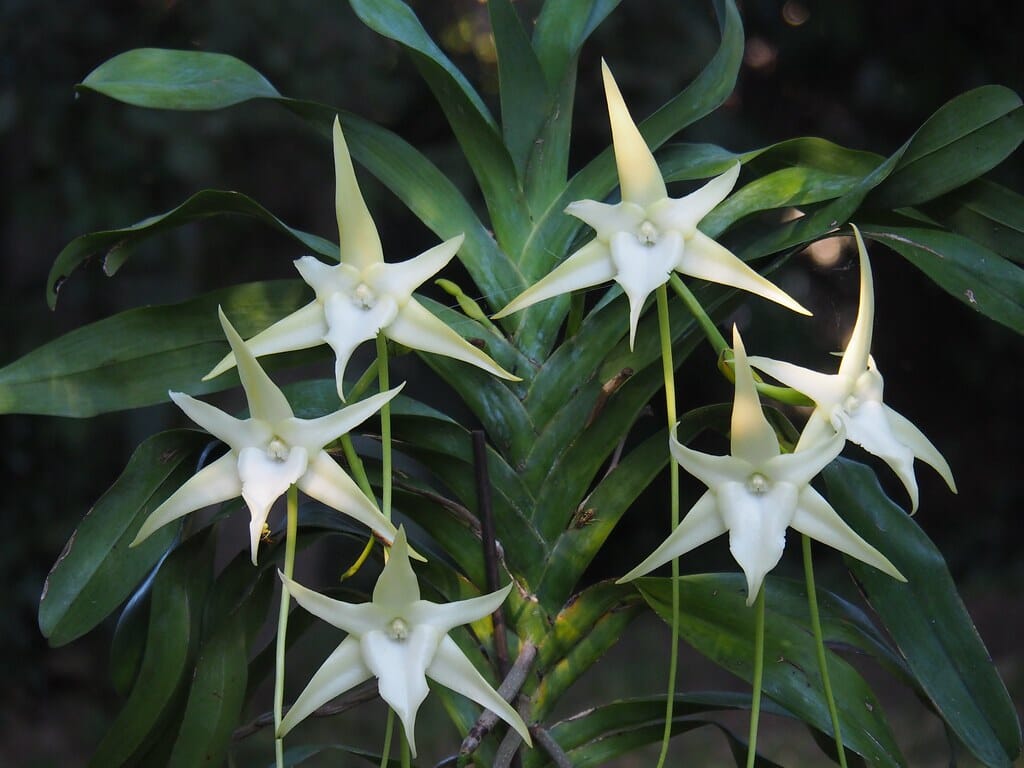La Foresta Orchids
Angraecum sesquipedale
Angraecum sesquipedale
Couldn't load pickup availability
Introducing the Enchanting Madagascar Comet Orchid: Angraecum sesquipedale
Originating from the lush landscapes of Madagascar, the Angraecum sesquipedale, also known as the Darwin's Orchid or Comet Orchid, captures the essence of the island's hot lowlands along its eastern coast. This remarkable orchid species thrives from Talanaro (Fort Dauphin) in the southern regions to Antalaha in the north, with reported sightings even on the picturesque island of Sainte-Marie. Inhabiting the edges of forests and perched upon the branches of trees, these elegant orchids flourish at altitudes below 100 meters where the gentle rustling of air prevails, creating an optimal environment for their growth.
Characterized by their striking presence, the Darwin's Orchid boasts a commanding stature, reaching heights of 90 to 120 cm. Its stems, adorned with numerous leaves arranged in an alternating pattern, add to its captivating allure. These elongated, coriaceous leaves, measuring 35 to 40 cm in length and 6 to 7 cm in width, exude a remarkable charm.
As the winter season sets in, the Comet Orchid graces us with its fragrant beauty. Its blossoms, numbering from 1 to 6, emerge on shorter stems than the leaves themselves. The inflorescence, enveloped in bracts, measures 30 cm in length, forming a stunning contrast against the foliage. The flower's fleshy and waxy texture, reminiscent of stars, unveils a diameter ranging between 17 and 22 cm, and in rare cases, even spanning an astonishing 46 cm from the tip of the dorsal leaf to the end of the spur. Often, these splendid blooms grace the plant one at a time, yet on mature specimens, multiple flowers can grace the same inflorescence, creating a mesmerizing display. Initially greenish upon opening, the petals transform into a pristine white shade within 2 to 3 days.
Cultivating the Angraecum sesquipedale demands the utmost attention to specific conditions. Adequate lighting is paramount, with a recommended level of 25000 to 35000 lux. While these orchids adore scattered light, preventing leaf burn, it's essential to shield them from direct southern sun exposure. Ensuring a consistent, gentle air movement is crucial for their well-being.
Temperature-wise, these orchids prefer a thermophilic climate. During summer, maintaining an average daytime temperature of 29°C and nighttime temperatures of 21-22°C, with a 7°C daily fluctuation, yields optimal results. As winter arrives, transitioning to average daytime temperatures of 23-24°C and nighttime temperatures of 16-17°C, while retaining the 7°C amplitude, is ideal.
A consistent humidity level of approximately 80% is essential to nurture the Darwin's Orchid's lush growth throughout the year.
When it comes to substrate and repotting, choosing a permeable medium like thick fir bark or tree fern fiber is recommended. Incorporating materials that enhance moisture retention, such as perlite and cut sphagnum moss, as well as wood charcoal for air circulation, contributes to a thriving environment. Repotting should be approached cautiously to preserve the root system, ideally selecting a slow-decomposing substrate like tree fern fibers to prevent setbacks. Repotting during the emergence of new roots accelerates the rooting process.
Watering should be generous during periods of active growth, ensuring impeccable drainage to prevent waterlogging. As winter approaches, reducing watering frequency is advised.
Fertilization plays a pivotal role in the life of the Darwin's Orchid. During growth spurts, a weekly dose of 1/2 to 3/4 the recommended orchid fertilizer dosage sustains the plant's vigor. Flower production is influenced by the previous season's leaf growth. Employing sustainable fertilizer year-round is beneficial, complemented by high-nitrogen variants in spring through mid-summer. As the season transitions to late summer and autumn, high-phosphorus fertilizer can enhance blooms.
This is a blooming size in a 4” pot about 1 to 2 years to bloom, grown from seed, limited!
For its winter dormancy, the Angraecum sesquipedale requires less water but should not experience prolonged dryness. A careful balance must be maintained, reducing both water and fertilization. As spring breathes new life into the plant, watering and fertilization should be gradually increased to support the burgeoning growth.








